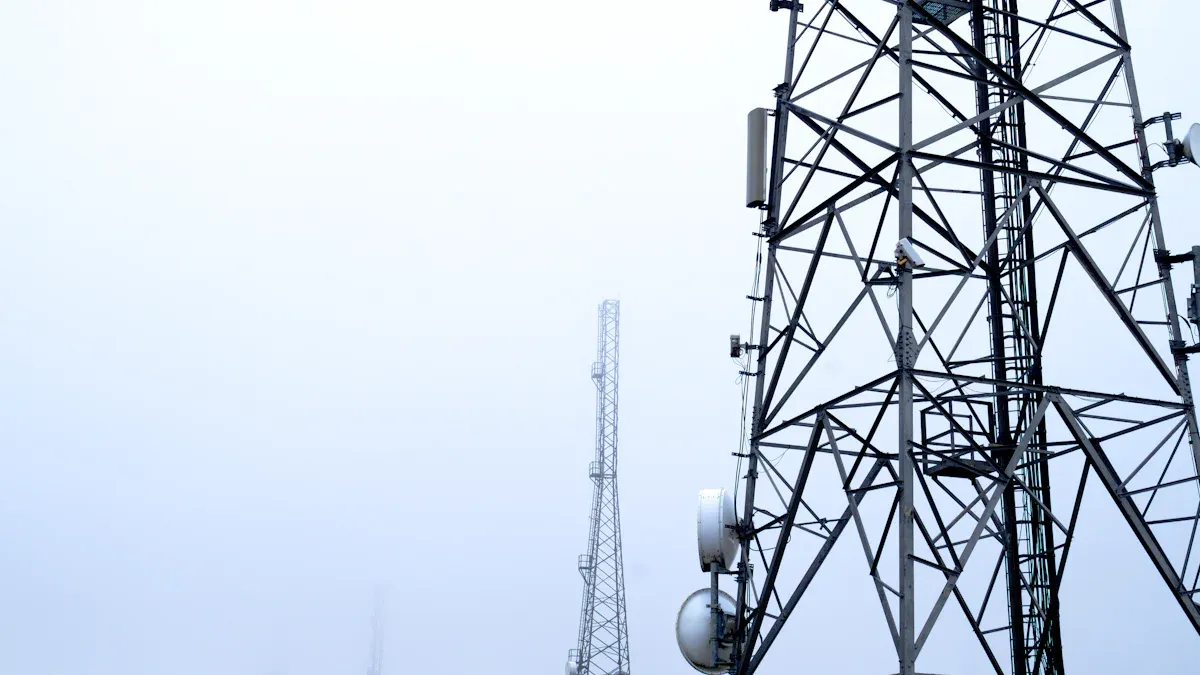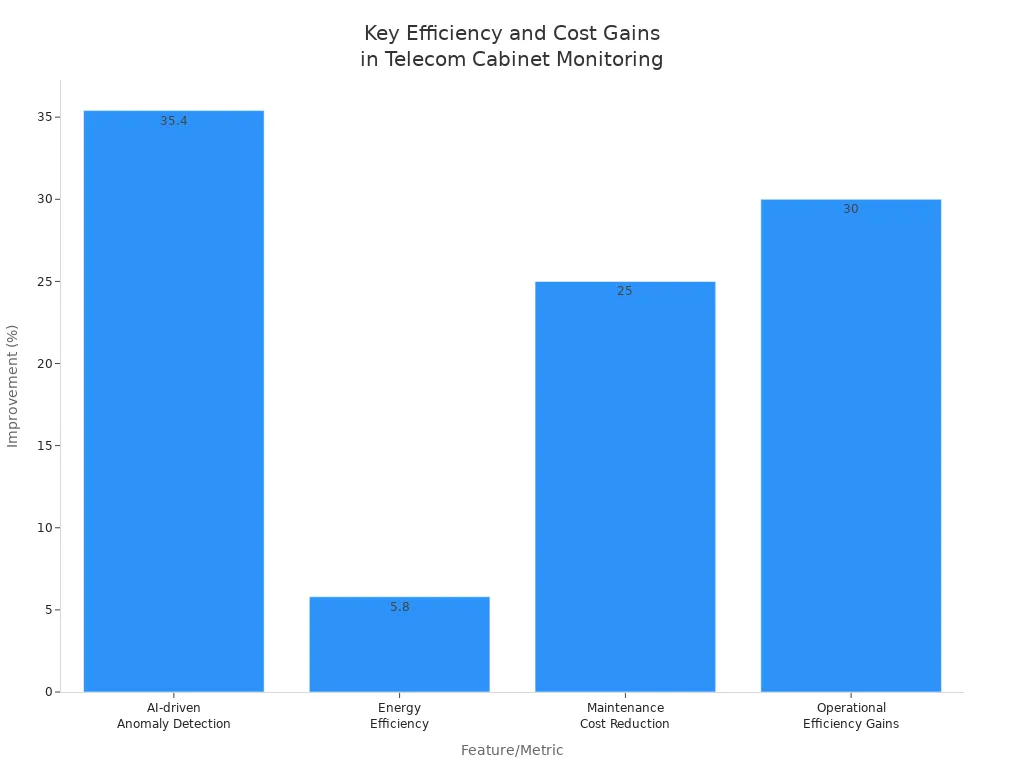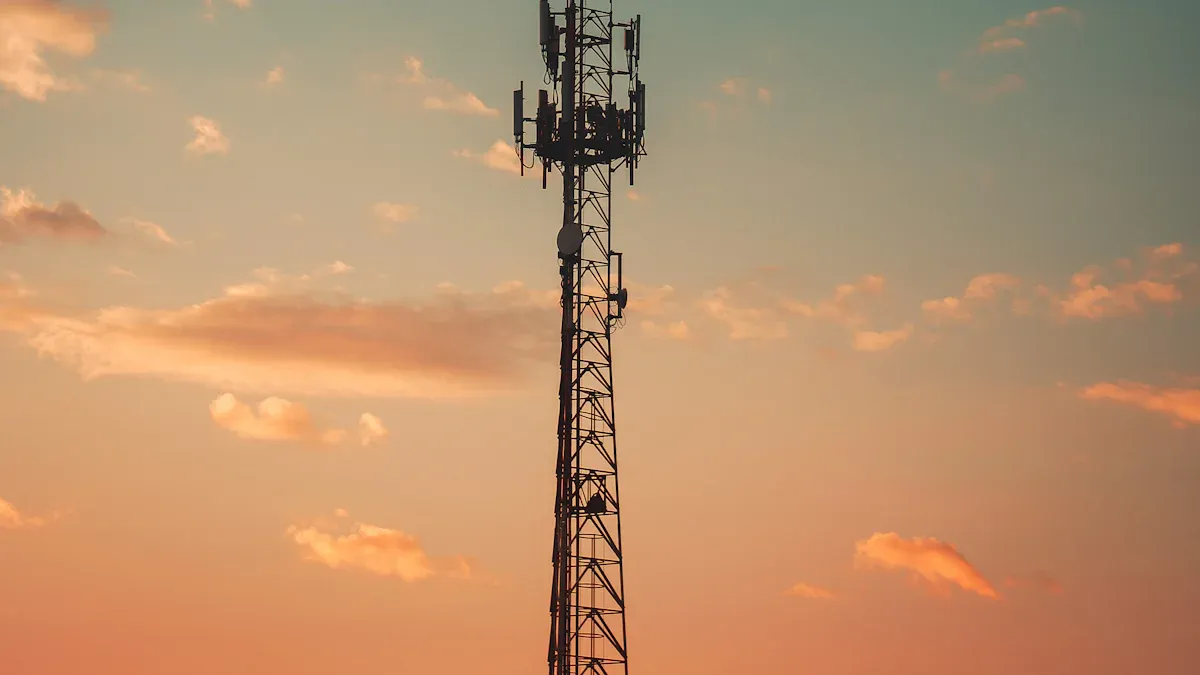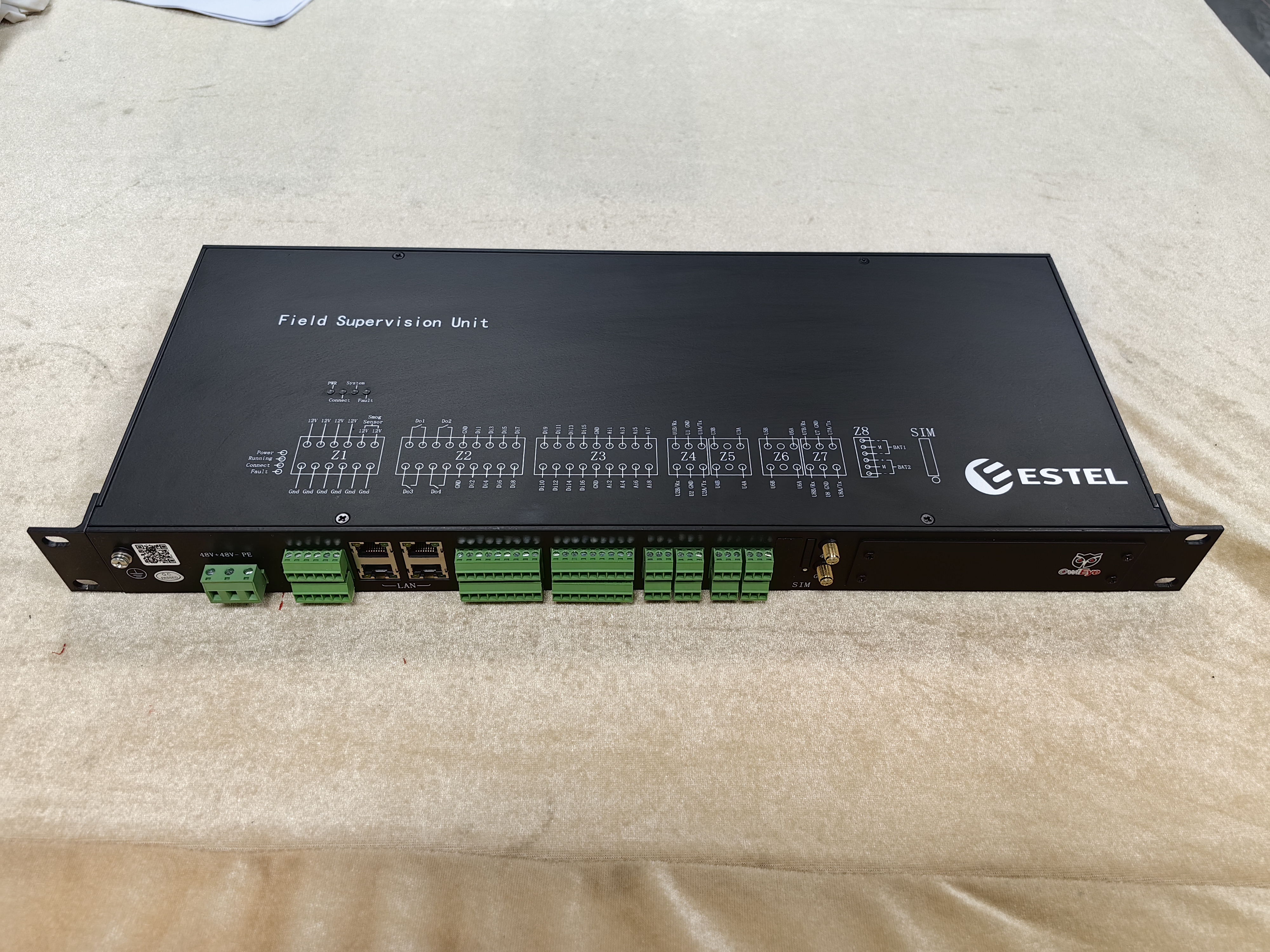New Demands and Challenges in Telecom Cabinet Monitoring from Single-Point to Network-Wide Integration

Telecom operators now face a critical transformation as monitoring expands from isolated cabinets to network-wide integration. Real-time oversight safeguards assets and improves operational efficiency. IoT sensors and AI-driven anomaly detection support faster fault identification and predictive maintenance, while cloud platforms unify data for immediate response. The chart below illustrates measurable gains in efficiency, energy savings, and maintenance cost reduction from these technologies.

An advanced Environment Monitoring System enables telecom networks to withstand climate-driven disruptions and evolving cybersecurity threats.
Key Takeaways
Telecom operators now use network-wide monitoring to get real-time data from all cabinets, improving response times and reducing downtime.
Scalable and modular systems with IoT sensors and AI help operators manage large networks efficiently and predict equipment failures before they happen.
Centralized management platforms unify data from multiple sites, enabling faster decisions, energy savings, and lower maintenance costs.
Cybersecurity and legacy system challenges require operators to upgrade infrastructure and train staff to protect networks from evolving threats.
Advanced Environment Monitoring Systems with real-time alerts and automation improve network resilience against climate events and operational risks.
The Shift

Single-Point Monitoring
Single-point monitoring once served as the standard for telecom cabinet oversight. Operators installed sensors or alarms at individual sites. Each cabinet functioned as an isolated unit, reporting only basic status updates such as door open/close or temperature thresholds. This approach provided limited visibility. Technicians often responded reactively, traveling to remote sites after receiving alerts or complaints. The lack of centralized data made it difficult to identify patterns or predict failures. As a result, downtime and maintenance costs remained high.
Network-Wide Integration
Network-wide integration has transformed telecom cabinet monitoring. Operators now deploy interconnected sensors and controllers across all sites. These devices feed real-time data into centralized platforms. The system aggregates information on temperature, humidity, power, and security from every cabinet. Operators gain a holistic view of the entire network. They can analyze trends, detect anomalies, and respond to issues before they escalate. Predictive analytics and remote management tools reduce the need for on-site visits. This integrated approach supports rapid scaling and adapts to new technologies like 5G and IoT gateways.
Drivers of Change
Several key factors drive the shift from single-point to network-wide monitoring:
Telecom operators seek to enhance network resilience and uptime. Continuous connectivity reduces outages caused by equipment failures.
Remote monitoring of environmental conditions, such as temperature and humidity, enables efficient maintenance. Fewer truck rolls lower operational costs.
Protecting expensive equipment from heat and thermal cycling extends its lifespan and reduces capital expenditures.
Modern systems offer deployment versatility. They support high-density configurations and future upgrades, including edge computing and IoT integration.
Real-time alerts and predictive maintenance improve operational efficiency and speed up response times.
Regulatory compliance plays a significant role. Operators must meet strict industry standards and local codes, such as IP/NEMA ratings, UL certification, NEBS compliance, and GR-487. Meeting these requirements ensures safety, performance, and environmental protection. Compliance also simplifies procurement and permitting, especially in regulated markets.
Network-wide integration not only meets technical demands but also addresses regulatory and business pressures, positioning operators for future growth and resilience.
New Demands
Real-Time Data
Telecom operators require immediate access to cabinet status across their networks. Real-time data enables rapid detection of temperature spikes, humidity changes, power fluctuations, and unauthorized access. Operators use advanced sensors and cloud-based dashboards to monitor these parameters continuously. This approach reduces downtime and supports proactive maintenance. Real-time alerts allow teams to respond quickly, preventing minor issues from escalating into major failures.
Scalability
Modern telecom networks demand scalable monitoring solutions. Operators address scalability by deploying modular enclosures and sensors that support easy expansion.
Modular sensor designs with plug-and-play capabilities simplify installation and system growth.
Centralized data aggregation platforms, such as Multitel’s FIRMSuite and Atlas, manage multiple cabinet sensors efficiently.
AI-driven analytics automate monitoring and predictive maintenance, reducing manual inspections.
Intelligent power monitoring with scalable PDUs ensures energy management across expanding networks.
IoT and cloud-based condition monitoring enable remote diagnostics and centralized control, essential for large-scale deployments.
These strategies allow operators to grow from single cabinets to network-wide systems while maintaining operational efficiency and security.
Interoperability
Integrating multi-vendor systems presents significant challenges. Operators must ensure compatibility between new and existing infrastructure, regardless of hardware or vendor.
Major industry players use rigorous system verification and end-to-end optimization to guarantee telecom-grade reliability.
Automation frameworks and AI help manage data overload and integration complexity.
Distributed monitoring workloads support thousands of sites in multi-vendor environments.
By focusing on compatibility and automation, operators reduce integration difficulties and maintain reliable network operations.
Centralized Management
Centralized management platforms have become essential for telecom cabinet monitoring.
Real-time monitoring with customizable threshold alerts for temperature, humidity, power, and security enables operators to focus on critical incidents.
Dashboards aggregate sensor data from multiple sites, providing unified access to key metrics.
Integration with communication tools ensures immediate notification to the right personnel.
Predictive maintenance features forecast equipment failures, allowing proactive scheduling.
Modular hardware and centralized control support efficient management of distributed infrastructure.
User-friendly dashboards reduce training time and support quick decision-making.
Centralized management improves operational efficiency by enabling faster response times, reducing downtime, and lowering maintenance costs. Operators have documented up to 30% energy savings and a 25% decrease in downtime using these platforms.
Predictive Analytics
Predictive analytics transforms how operators prevent failures and optimize maintenance.
Feature | Impact |
|---|---|
Temperature Monitoring & Predictive Analytics | Prevents overheating and hardware failure |
Real-time Alerts & Insights | Reduces downtime with quick responses |
Predictive Maintenance | Forecasts failures for timely interventions |
Anomaly Detection Algorithms | Stops service disruptions before they spread |
IoT Integration | Automates responses and improves proactive maintenance |
AT&T’s use of predictive analytics improved network reliability by 25% and reduced operational costs by 40%. Automated responses in monitoring software enable fast remediation, such as rerouting traffic or isolating faulty devices. AI and machine learning analyze historical data to predict hardware failures, enabling timely interventions and preventive maintenance. Remote sensors and cloud-based management platforms provide continuous data, reducing manual inspections and supporting predictive maintenance planning.
IoT and Automation
IoT and automation solutions have revolutionized telecom cabinet monitoring.
Sensors monitor environmental parameters like temperature, humidity, dust, power, and intrusion.
Edge computing enables local data processing and automated responses.
AI analytics enhance real-time monitoring platforms.
Automation platforms support remote site management.
Integration with satellite communications ensures connectivity in remote areas.
These solutions deliver measurable improvements, including reduced downtime, fewer emergency site visits, lower maintenance costs, and enhanced asset protection. Operators benefit from increased uptime reliability and network stability, even in harsh environments.
Emergency Management
Telecom networks must remain resilient during emergencies such as power outages, fires, or extreme weather events. An advanced Environment Monitoring System detects early warning signs, such as smoke, water intrusion, or abnormal temperature rises. Real-time alerts and automated responses help operators isolate affected cabinets, reroute network traffic, and dispatch emergency teams promptly. This proactive approach minimizes service disruptions and protects critical infrastructure.
Standards (ETSI, etc.)
Compliance with industry standards shapes system design and ensures reliability.
Standard | Influence on Telecom Cabinet Monitoring and System Design |
|---|---|
Defines environmental conditions and tests, ensuring telecom equipment durability in harsh environments. | |
IEC 60529 | Specifies ingress protection (IP) ratings, critical for enclosure design to prevent dust and water ingress. |
ISO 9227 | Addresses corrosion resistance, important for equipment longevity in corrosive environments. |
NEBS standards, such as Telcordia GR-63-CORE, set requirements for environmental protection, reliability, and thermal design. Compliance involves rigorous testing and influences design cycles and operational strategies. Meeting these standards ensures equipment durability, operational reliability, and regulatory approval, especially in regulated markets.
Environment Monitoring System
An Environment Monitoring System forms the backbone of modern telecom cabinet oversight.
Temperature sensors detect overheating or freezing conditions.
Humidity sensors identify moisture risks.
Smoke detectors provide early fire warnings.
Water sensors alert teams to leaks or flooding.
Door sensors monitor security and access control.
Sensors track cooling and ventilation performance to maintain safe equipment temperatures.
These systems use integrated sensor suites within weather-resistant units. Operators access real-time data and alerts through dashboards or mobile devices. Smart technologies, such as AI and machine learning, predict potential issues and automate responses. The Environment Monitoring System integrates with network management platforms, providing centralized control and supporting proactive maintenance. This approach reduces downtime and ensures accurate monitoring in harsh outdoor conditions.
Key Challenges

Data Overload
Telecom cabinet monitoring at the network-wide level generates massive volumes of data. Each node, from cell sites to user equipment, continuously streams performance metrics, environmental readings, and security alerts. Operators must process geo-located RF measurements, signal quality indicators, and thousands of connection records across distributed locations. Overload occurs when resource utilization, such as PDCCH CCE, exceeds critical thresholds—often set at 70%. This triggers congestion and can degrade network performance.
Aspect | Description |
|---|---|
Scale of Data Generated | Monitoring covers numerous network nodes and user devices, collecting geographically distributed RF measurements and performance metrics. |
Data Overload Detection | Systems track cell-level metrics like utilization and connection counts, flagging overload when thresholds are breached. |
Data Management Strategies | Operators use analytics modules to detect overloaded cells, retrieve neighbor performance, and dynamically offload connections. Real-time management and geo-binned data help prevent congestion and optimize resource use. |
Quantification of Data | The scale is vast, involving multiple nodes and continuous data streams, though exact volumes vary by network size and density. |
Operators rely on dynamic analytics and automated offloading to manage this complexity. Real-time monitoring and neighbor cell coordination help balance loads and maintain service quality.
Cybersecurity
Telecom cabinet monitoring systems face a rapidly evolving threat landscape. Attackers target these systems for espionage, sabotage, and financial gain. The most common threats include:
System intrusions and unauthorized access
Insider threats, both accidental and malicious
Social engineering, phishing, and ransomware attacks
Spyware, business email compromise, and API exploitation
Recent incidents highlight the severity of these risks. In 2024, the Salt Typhoon espionage campaign targeted major U.S. telecom providers, seeking sensitive customer data. Physical sabotage, such as damage to undersea cables, demonstrates hybrid warfare tactics. Regulatory bodies have responded with hefty fines and new mandates for risk management.
The Verizon 2025 Data Breach Investigations Report notes a sharp rise in system intrusions and insider threats, especially in the EMEA region. Social engineering now accounts for nearly one in five reported breaches.
Financial losses from cybercrime are staggering, with U.S. companies losing $12.5 billion in 2023. Human error remains a critical vulnerability. Operators must invest in modern infrastructure, comprehensive risk management, and continuous staff training to defend against these threats.
Legacy Systems
Legacy infrastructure presents significant barriers to modern telecom cabinet monitoring. Older SCADA and control systems cannot handle the speed, volume, or complexity of data generated by IoT sensors and edge computing devices. These limitations restrict real-time data collection and analysis, which are essential for predictive maintenance and rapid response.
Common challenges include:
Limited connectivity and data sharing across diverse systems
Reduced operational visibility and efficiency
Inability to support advanced analytics or automation
Operators address these issues by introducing edge computing platforms that enable local data processing. Solutions like ThingWorx Kepware Server connect and manage diverse devices, supporting digital transformation. Modernization reduces downtime, lowers costs, and creates new opportunities for efficiency.
Cost
Expanding from single-point to network-wide monitoring increases both capital and operational expenses. Operators must invest in advanced sensors, robust enclosures, cloud platforms, and cybersecurity tools. Ongoing costs include software licensing, data storage, and skilled personnel for system management.
Budget constraints often force operators to prioritize upgrades, balancing immediate needs against long-term benefits. Modular hardware and scalable platforms help control costs by allowing phased deployments and targeted investments. Preventative maintenance and automation further reduce expenses by minimizing emergency repairs and truck rolls.
Maintenance
Network-wide monitoring introduces new maintenance challenges. Equipment failures, water leaks, HVAC malfunctions, and security breaches can occur without warning. Power outages may be difficult to diagnose as internal or external. Operators must ensure continuous protection against environmental hazards and vandalism.
Key maintenance strategies include:
Deploying remote monitoring solutions with real-time alerts
Using intrusion detection sensors and environmental monitors
Differentiating power alarms to pinpoint outage sources
Implementing scalable RTUs with SNMP reporting for integration
Customizing cabinets for environmental protection and easy upgrades
Routine preventative maintenance, seasonal checks, and network hardening improve reliability. Operators standardize processes with technology and mobile apps, reducing errors and improving coordination.
Well-designed cabinets shield equipment from dust, water, and physical impacts, extending lifespan and reducing operational costs.
Climate Resilience
Extreme weather events pose growing risks to telecom infrastructure. Floods, heatwaves, and storms can disrupt cabinet operations, damage equipment, and cause service outages. Operators must design cabinets and monitoring systems to withstand these hazards.
Climate resilience strategies include:
Using weather-resistant enclosures and corrosion-proof materials
Installing sensors for early detection of water, smoke, and temperature anomalies
Hardening networks with robust materials and structural upgrades
Scheduling seasonal maintenance to prepare for changing conditions
Proactive planning and rapid response protocols help minimize downtime and protect critical assets during climate-driven events.
Network Operations Center (NOC)
The Network Operations Center (NOC) serves as the nerve center for telecom cabinet monitoring. NOC teams monitor, maintain, and resolve network performance issues across distributed infrastructure. Their responsibilities include event detection, incident management, capacity planning, and change coordination.
Key coordination challenges:
Managing tiered organizational structures to prevent staff burnout
Ensuring access to comprehensive operational metrics for early issue detection
Addressing high turnover and difficulties in hiring skilled personnel
Maintaining standardized processes for consistent troubleshooting
Effective NOC operations require skilled staff, integrated monitoring tools, and a robust process framework. Coordination with technical specialists and external vendors ensures rapid resolution of infrastructure events.
Cloud and Connectivity
Cloud adoption transforms telecom cabinet monitoring by enabling scalable, secure, and flexible operations. Operators leverage hyperscale, telecom, and edge data centers to support dynamic workloads and real-time analytics.
Data Centre Type | Key Features for Telecom Cabinet Monitoring |
|---|---|
Hyperscale | Massive scalability, high-speed networks, robust security, dynamic resource allocation |
Telecom | High connectivity, network equipment integration, reliable routing for cloud services |
Edge | Proximity to end-users, reduced latency, real-time data processing, enhanced scalability for distributed cabinet monitoring |
Cloud platforms must integrate seamlessly with existing infrastructure and security tools. Operators implement Zero Trust frameworks, micro-segmentation, and robust access controls to limit threats. Edge computing processes data closer to the source, reducing latency and network load. Physical security measures, such as tamper-resistant enclosures, further protect critical assets.
Cloud and edge solutions enable telecom networks to scale resources, maintain high connectivity, and ensure data security in an increasingly complex environment.
Best Practices
Advanced Monitoring Tech
Operators deploy advanced monitoring technologies to address the demands of modern telecom networks. Real-time fiber monitoring detects faults and degradation without requiring active onsite equipment. Reflectorless monitoring covers the entire PON infrastructure, enabling rapid fault isolation and reducing unnecessary truck rolls. Compact, cost-effective designs make these solutions practical for both fixed and mobile networks. Scalable Power Distribution Units (PDUs) with hot-swappable breakers and integrated battery health monitoring support evolving network needs. Solid-state PDUs offer increased reliability, surge protection, and remote access, ensuring continuous operation in critical environments.
Cybersecurity Measures
A robust risk management approach protects telecom cabinet monitoring infrastructure. Operators conduct cyber threat assessments, develop sector-specific risk profiles, and align policies with the evolving threat landscape. Security by design principles guide infrastructure from planning to operation. Best practices include strong access controls, regular system updates, continuous network monitoring, and encryption of all data. Physical security measures, such as biometric access and surveillance, further safeguard critical assets. Regular employee training and incident response planning ensure resilience against unpredictable cyber threats.
IoT and Serial Consoles
IoT devices and serial consoles enhance remote management and diagnostics. Gateways like the USR-EG828-GL support edge computing and multiple protocols, enabling real-time data collection and local processing. Integration with IoT platforms and AI models provides intelligent, on-site diagnostics. Serial consoles offer secure, scalable remote access through Telnet, SSH, and web clients, supporting both legacy and modern equipment. Centralized management software streamlines monitoring and event notifications.
Fiber Monitoring
Fiber monitoring solutions deliver real-time intrusion detection and environmental protection. Distributed Acoustic Sensing (DAS) and Distributed Temperature Sensing (DTS) identify vibrations and temperature changes, maximizing uptime. Modular enclosures support future expansions, while rugged, IP-rated designs protect against hazards. Operators must consider the complexity of monitoring active fibers, which requires careful signal management to avoid disrupting live traffic.
Cloud Platforms
Cloud platforms facilitate centralized control and analytics for telecom cabinet monitoring. Systems like AIO CMS provide real-time dashboards, automated reporting, and unified views across multiple sites. Cloud integration enables remote monitoring, data redundancy, and scalability. Operators gain actionable insights on network health, performance, and security, supporting proactive maintenance and rapid response.
LoRa and Wireless
Wireless technologies such as LoRa enable efficient monitoring in remote or hard-to-reach locations. Rugged hardware with surge protection ensures reliable operation in harsh environments. Combining cellular and satellite connectivity guarantees continuous monitoring. Wireless sensors simplify installation, reduce wiring complexity, and operate during power outages, supporting flexible deployment and minimizing downtime.
Centralized Environment Monitoring System
A centralized Environment Monitoring System consolidates data from temperature, humidity, and power sensors. A master station reduces alarm fatigue by prioritizing critical issues. Remote access allows technicians to adjust settings and resolve problems quickly. Automated controls can switch to backup power or trigger alerts, reducing human error and downtime. Regular maintenance of sensors and RTUs ensures system reliability. This approach improves response times, reduces travel costs, and supports uninterrupted telecom services.
Operators who implement a centralized Environment Monitoring System report faster interventions and lower operational costs, ensuring network resilience and service continuity.
Future Trends
AI and Automation
Artificial intelligence and automation continue to transform telecom cabinet monitoring. Operators now deploy AI-powered sensors for real-time tracking of temperature, humidity, and other environmental factors. These sensors support predictive maintenance by forecasting failures and optimizing service schedules.
AI-driven dynamic thermal management uses enclosure air conditioners that adjust cooling output based on sensor data, maintaining optimal temperatures and reducing downtime.
Automated adjustments in cooling and power distribution improve operational efficiency, lower repair costs, and extend equipment lifespan.
Sustainable enclosure designs use eco-friendly materials and modular components, supporting network growth and reducing environmental impact.
AI tracks task completion and productivity across vendors, providing better project oversight.
Automation of billing through AI-validated 3D scans and photo evidence accelerates payments and reduces disputes.
Predictive maintenance powered by AI prioritizes repairs and reduces unnecessary field visits.
AI-powered workflows minimize manual work, improve safety, and enhance vendor accountability.
AI and automation enable telecom operators to achieve higher reliability, lower costs, and greater transparency in network operations.
Smart Cities
Smart city initiatives drive the integration of AI and IoT technologies into telecom cabinets. These cabinets now support real-time monitoring, predictive maintenance, and remote management, which are essential for interconnected urban systems like smart traffic and public Wi-Fi. Edge computing infrastructure inside cabinets reduces latency and improves network efficiency, meeting the demands of smart city applications.
Sustainability remains a priority, with energy-efficient cooling, solar-powered options, and eco-friendly materials. Modular and scalable cabinet designs allow flexible expansion as urban networks grow. Enhanced security features address both cybersecurity and physical threats, ensuring uninterrupted services for critical city functions.
Evolving Standards
Telecom standards continue to evolve, reflecting new technologies and regulatory requirements. Organizations such as ETSI and IEC update guidelines to address AI integration, IoT security, and environmental sustainability. Operators must adapt to stricter compliance for data privacy, equipment durability, and energy efficiency.
A focus on interoperability ensures that new systems work seamlessly with legacy infrastructure. Regular updates to standards drive innovation and maintain network reliability.
Preparing for Change
Telecom operators must remain agile to succeed in a rapidly changing environment. They should invest in scalable, modular monitoring systems that support future upgrades. Continuous staff training and process improvement help teams adapt to new technologies and standards.
Operators who embrace AI, automation, and sustainable practices position themselves for long-term success. Proactive planning and regular system assessments ensure resilience against emerging threats and evolving market demands.
Telecom operators face new demands such as real-time data, scalability, and centralized management. They encounter challenges from cybersecurity threats, legacy systems, and climate events. Adopting advanced best practices and an Environment Monitoring System helps protect assets and improve efficiency.
Operators should regularly review standards, invest in staff training, and plan for future upgrades to ensure network resilience.
FAQ
What is the main benefit of network-wide cabinet monitoring?
Operators gain real-time visibility across all sites. This approach improves response times, reduces downtime, and supports predictive maintenance. Centralized data helps teams identify trends and prevent failures before they impact service.
How does IoT improve telecom cabinet monitoring?
IoT sensors collect detailed environmental and operational data. These devices enable remote monitoring, automate alerts, and support predictive analytics. Operators use this information to optimize maintenance and protect critical assets.
Why is compliance with standards like ETSI important?
Compliance ensures equipment durability, safety, and regulatory approval. Standards guide system design and testing. Operators who follow these guidelines reduce risks and simplify procurement in regulated markets.
What challenges do legacy systems present?
Legacy systems often lack compatibility with modern sensors and analytics platforms. They limit data sharing and slow response times. Operators must upgrade or integrate new technologies to achieve effective network-wide monitoring.
Tip: Regularly review system compatibility and plan phased upgrades to avoid disruptions.
See Also
Best Practices For Monitoring Outdoor Telecom Cabinets Effectively
A Comprehensive Guide To The Applications Of Telecom Cabinets
The Importance Of Upgrading Telecom Cabinets By The Year 2025
Analyzing Telecom Cabinet Designs And Their Associated Costs
Latest Innovations And Trends In Outdoor Telecom Cabinet Technology
CALL US DIRECTLY
86-13752765943
3A-8, SHUIWAN 1979 SQUARE (PHASE II), NO.111, TAIZI ROAD,SHUIWAN COMMUNITY, ZHAOSHANG STREET, NANSHAN DISTRICT, SHENZHEN, GUANGDONG, CHINA


